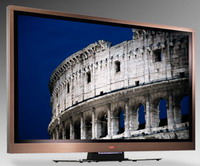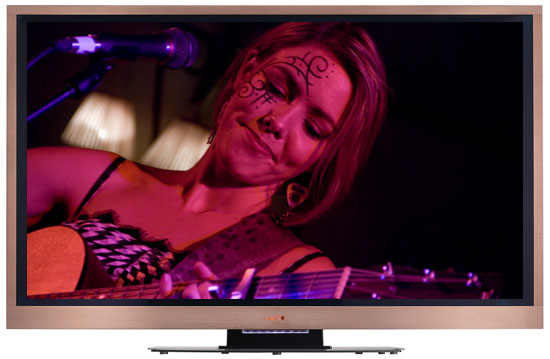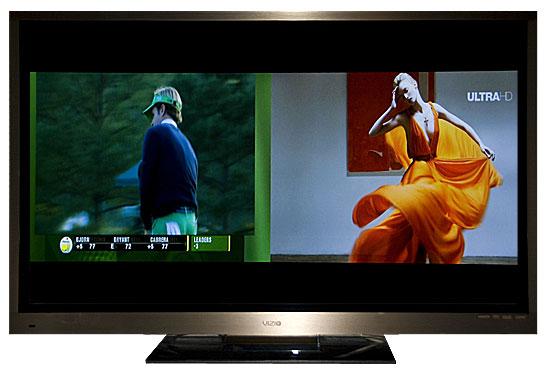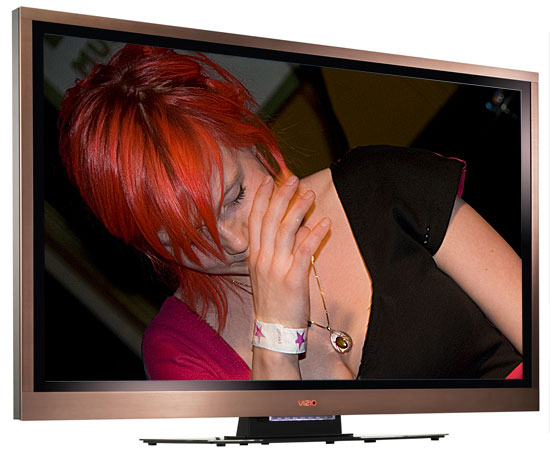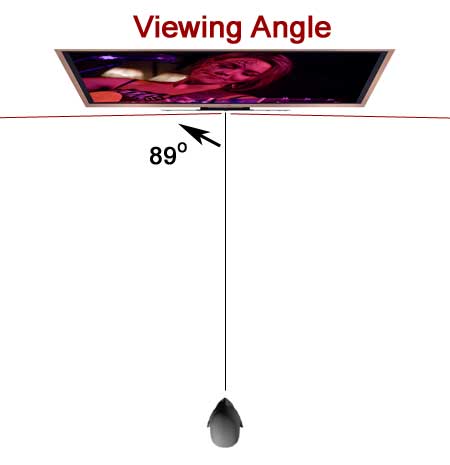
|
|
 |

|


Dick De Jong April 7, 2007 HDTV Solutions Five feet. Any discussion about VIZIO's VM60P Plasma HDTV must begin with that mammoth measurement and end with this price punctuation – under $3000. Inches and dollars might not be the greatest gauge of the quality of an HDTV, but a 60" plasma for $2895 is an awfully big elephant in our review facility that must be acknowledged. VIZIO has good reason to call this TV, MAXIMVS. Since we are throwing around numbers, here's another that must be added to the equation, 1366 x 768 native resolution. This VIZIO is a 720p plasma even though it accepts 1080p sources, which it downscales to 720p. And finally, let's add a little spice to our spec soup, 7000:1. That's the contrast ratio of this beast of a plasma TV. While the newest LCD models are boasting twice that, most LCDs are still languishing in the under 1500:1 range. Of course, all the impressive stats don't mean a lick unless the TV can hit with men on base. (Can you tell that baseball season just started?) With HD content, the VM60P consistently hits for extra bases. Standard definition programs can be like wicked curve balls. O.K., we'll stop with the sports metaphors. Perhaps VIZIO's self admonition that they print on their box says it best, "This VIZIO TV is optimized for HDTV, without an HD source, it's just an ordinary TV." And at five feet, it can reveal that ordinariness in a grand manner. Now, I've received emails chastising me for not holding VIZIO's feet to the fire and demanding that they make a TV that does a great job of displaying SD material. From my viewpoint, I admire VIZIO for their candor. If they touted their HDTVs as great handlers of SD material and didn't deliver, then it would be my duty to kindle a blaze. With that said, this plasma does not do a bad job with SD. Sometimes, it looks quite good. But occasionally, it looks like chopped liver. HD material, on the other hand, can look great and in glorious 60". Though don't expect the fine detailed sharpness that a 1080p TV can provide. Out of the Box
With the VM60P, VIZIO has departed from its usual palette of a black bezel and silver speakers. This plasma sports a brushed copper bezel. To maintain a svelte profile, VIZIO enclosed the pair of 20W speakers inside the bezel below the screen. Since they point downward, a snap-on translucent sound reflector is included, which directs the sound out to the audience. The control buttons are inset on the left side. The only adornment on the front is an illuminated VIZIO that changes from yellow to white when the TV is turned on. The other way that you can tell this TV is switched on is by the noise it makes when this colossus is running. It's not loud or distracting, but you do get the impression that there's some heavy lifting going on inside to present a 60" image. Once again, the connectors are located on the back of the TV facing downward. Now we have complained about this ad nauseum and with smaller TVs, the location has been more of an annoyance. With this unit, it is definitely an obstacle. If you place your TV on a stand near the wall, with a lighter model, it is fairly easy for one person to maneuver it so you can reach around back and attach a cable. With a 180 pound monster, swiveling is not a one person task. Even if you do turn it at an angle, reaching around a five foot screen is a job for the limber and long armed. At least, once you traverse back there, you are greeted with the most HDMI connectors (4) that we have seen on a TV. Adding to the mix are a stereo pair of Audio inputs, (which are linked to the HDMIs), two Component inputs (YPbPr) with matching stereo Audio Ins, two Composite (with Audio), two S-Video (with Audio), one VGA (15 pin D-Sub) with a stereo Audio In mini-plug, and a Service port. Also on the panel is a stereo pair of analog Audio Outs, which is unamplified. So you would connect them to your home theater receiver and not directly to a set of external speakers. In addition, an SPDIF (optical) digital Audio Out is provided and is active when you are receiving digital audio from programs from the tuner input (see below). If you are bypassing the TV's speakers, you can turn them off in the Audio Settings menu. The one RF connector links to the internal NTSC/ATSC/QAM tuner. The tuners are not integrated in that the digital (ATSC) and analog (NTSC) channels are segregated. To switch from one to the other, you have to hit the TV button on the remote to cycle from DTV to TV. Also, in Setup, you have to scan the channels separately. We would prefer a more integrated system where you could surf from analog to digital channels by simply hitting the Channel buttons. Since the tuner system is also Clear QAM compatible, you can attach your cable TV signal directly into the RF connector and tune in unscrambled cable stations.
One of us here is a dual-tasker and loves the VIZIO's PIP and POP features. Considering the size of the screen, with the side by side POP, you basically can display two 30" pictures at once. Since not that long ago, we thought that a 27" TV was enormous, this POP is luxurious. An added benefit on this side by side configuration is that each image is being displayed at approximately SD resolution, which makes SD content look much better.
The backlit, black remote is not for the aging eyes. Though we like the layout of the buttons, in low light, those little stenciled descriptors are not the easiest to read. We do definitely appreciate the separate buttons for different Input categories, (HDMI, TV, AV, Component). Though it was a bit odd that the RGB button was bunched in with the PIP controls. On a remote related topic, we have noticed the other VIZIOs we have reviewed seem particularly susceptible to other remotes. For example, with the VM60P, it turns on when we hit the +10 button on our Oppo remote. Setup The Video Settings Menu on the VIZIO provides the basic controls: Brightness, Contrast, Saturation, Hue and Sharpness. Also, you have Picture Mode presets labeled Vivid, Sport, Game, and Movie, as well as a Custom choice. Interestingly, if you select the Reset to default, Vivid is chosen. Since we like to have a full range of adjustments, we always pick Custom and work from there. Under the Advanced submenu are controls for Noise Reduction, Fleshtone, Dynamic Contrast, and Color Temperature. The Color Temperature selections are User, Cool, Standard and Warm. For added control, User includes sliders for Red, Green, and Blue, which default to a midpoint of 50. At those settings, User was the coolest of the four choices. Cool was a little warmer (slight yellow tinge), Standard was even warmer, and Warm was downright yellow. We stuck with User. According to our test patterns, the screen produced even displays of gray scale and color across the 60" expanse. The Brightness and Contrast controls were robust enough to allow us to tune in those settings to our satisfaction. We're not giving exact numbers because they changed depending on the Input. And we know it will vary for you depending on your setup. In the beginning, we like to turn most of the advanced features either way down or off, which is what we did for Fleshtone and Dynamic Contrast. (In later tests, we did not really like the artifacts caused by turning on Fleshtone or Dynamic Contrast, so we always left them off.) Noise Reduction has two controls, Motion and Digital. We set Motion to Adaptive and Digital down to 10. As an additional test for deinterlacing and noise reduction, we have been running our review units through their paces with a DVD full of video processing tests. This HQV disc is produced by Silicon Optix, who makes their own brand of video processing chips. Even so, we find that the DVD offers some good tests that we can use to compare TVs. We just received the HD-DVD version of the HQV disc so we popped it into our Xbox 360 HD-DVD player and set the output to 1080i, which let's us check the VIZIO's deinterlacing prowess. The HDTV performed excellently on both jaggies and noise tests. Performance We would suggest starting with HD material to get a feel for the picture settings that you want. SD programming is just too fickle especially with the VM60P. You will feel that you are constantly chasing your tail trying to settle on a satisfying skin tone or saturation level. With HD sources, especially HD-DVDs, we had a higher quality, more stable picture to adjust. Once dialed in, we could partake in the joys of the plasma's extended contrast range. Many of the shadows in the spooky corners of Sleepy Hollow were made visible in creepy corporeality. Often with LCDs, the darker grays were all crushed to black. The sets on West Side Story (broadcast on HDNet Movies) were radiantly Technicolor. And the swirling, sanguine seas in the Japanese classic Kwaidan were surrealistically supernatural. The NBA in HD on a five foot screen may not be as good as a front row seat next to Jack at a Lakers game, but you're definitely close enough to read the tattoos on Kobe's arms. And baseball in high definition, it's like sitting behind the dugout at Wrigley Field. Now, to rein in our enthusiasm, when we played the HD-DVD of Casablanca, (which, for all you youngsters, was shot in B&W), when we looked closely at Ingrid Bergman's face, we saw the VM60P working hard to maintain a smooth shading. Every so often, it would lose the battle and we noticed a slight banding. To be fair, we're standing much closer to the screen than normal; and at a proper viewing distance, only the most discerning eagle eyed would see this. Gears of War on the Xbox looked great, though occasionally the interstitials would be a little sparkly. If anything at 60", slogging through bloody, dismembered body parts might be a bit too graphic for the squeamish. With playing back both HD-DVDs and Gears on the Xbox, we tried both the VGA and Component cables. The VGA color seemed more stable but at the cost of saturation, which you cannot adjust in the VGA Video Settings menu. We usually opted for the Component cable. Also, we compared the 1080p and 720p signals from the Xbox. Remember that the VIZIO downscales 1080p to the HDTV's native resolution of 720p. We would go back and forth on whether there was a difference and what it was. Let's just say, try it for yourself and let us know what you think. Next, we connected our laptop to the VM60P with a VGA cable. The manual suggests that for the best picture quality that we set the computer's resolution to 1024 x 768, which we dutifully tried. But we were not surprised to see that it stretched the computer image horizontally. So, since the native resolution of the VIZIO is 1366 x 768, we figured that we should set the laptop to that also. After engaging the Auto Adjustment feature in the Video Settings menu, the image on the TV was perfectly positioned and not stretched. Looking at photos of a scarlet haired Finnish singer on the big 60" screen was extreme. If you zoomed in, you could easily read the number on her wristband and scrutinize the bug suspended in her necklace. Internet pages were sharp and easy to read.
But I would hesitate to use this plasma for computer use because of the slight possibility of image retention. Simply, if an image stays too long on the TV, it may leave a ghost on the screen that is visible when the image is no longer displayed. Often the ghost will disappear over time, but in extreme cases it could burn-in to the screen and never go away. To be clear, we never encountered burn-in on the VM60P. In the past, plasma TVs gained a reputation for being susceptible to image retention. Newer models in the last few years have come up with techniques to essentially eliminate the problem. With the VM60P, we did notice ghosting when a particularly bright screen image would change to a solid dark background. We must say that in normal viewing, as images were constantly moving and changing, we never noticed ghosting. VIZIO does provide an Image Cleaner feature, which will remove ghosts. Though they warn, "This feature will not remove images that have been displayed too long." We have never encountered any problems with burn-ins on plasmas. But if you are spooked by ghosting, then you should consider an LCD. As we have said, we like plasmas for their high contrast ratio and also for their truly wide viewing angles. This VIZIO does not disappoint. Even from a severe angle, the color remains saturated and the picture sharp. Of course, one of the drawbacks of plasmas is that their front glass is more reflective than LCDs. Indeed, the VM60P does reflect bright backgrounds, though it really isn't distracting when the TV is on.
Finally, the stereo 20W speakers will not rock and roll your world even when the volume is turned all the way up. The flip side is that even at full volume, the speakers don't rattle and the sound fidelity is good. But if you want sonic booms that fit the size of this HDTV, you need to invest in a more muscular receiver and speaker system. Conclusion
Star Ratings Second, we have given only two 5 Star ratings, which we reserve for truly outstanding accomplishment. Performance: 4.5 Features: 4.5 Ease of Use: 4.5 Value: 4.5 |
Bookmark:
![]() del.icio.us
del.icio.us
![]() Reddit
Reddit
![]() Google
Google
| Send this Page | Print this Page | Report Errors |



